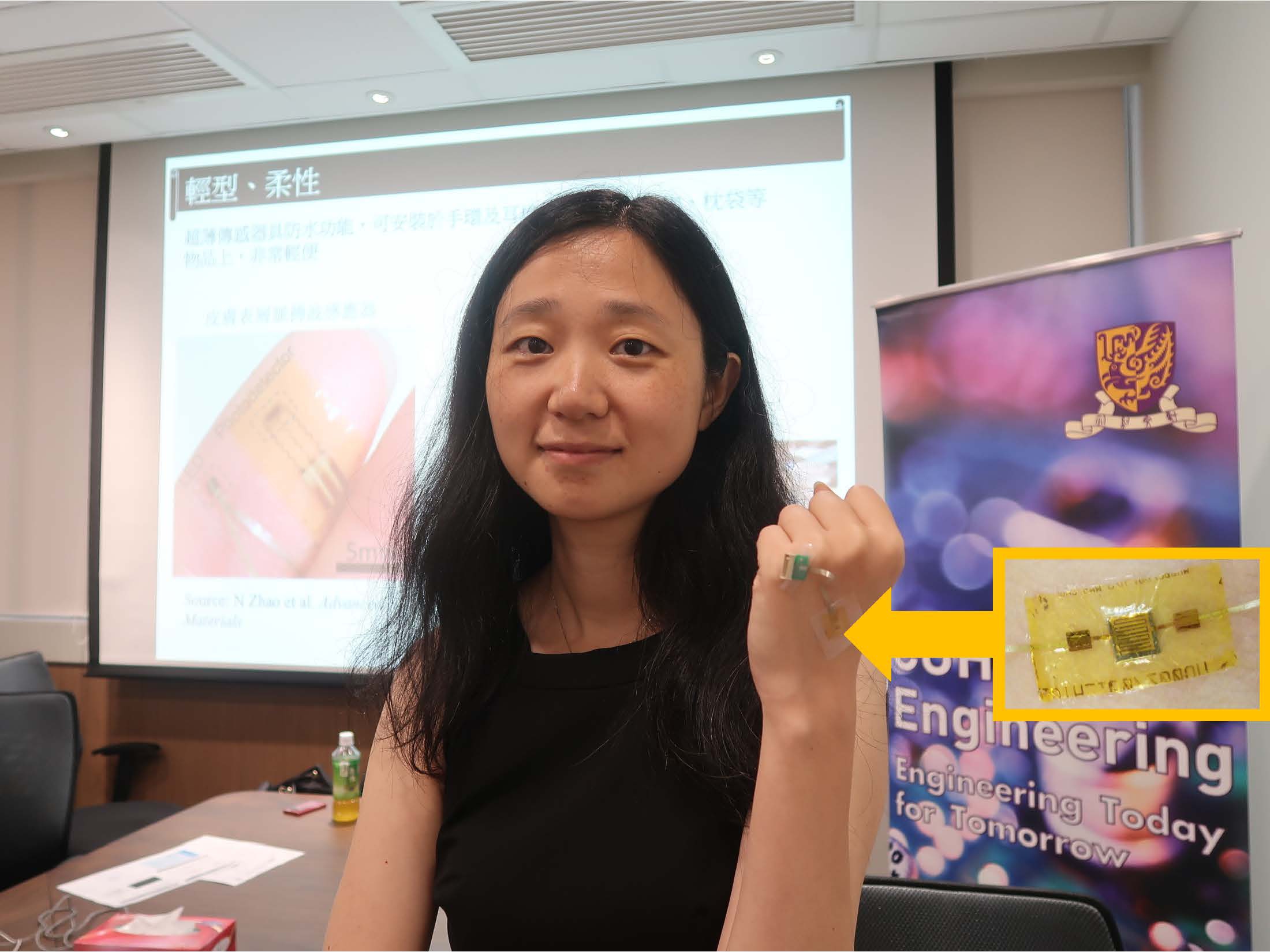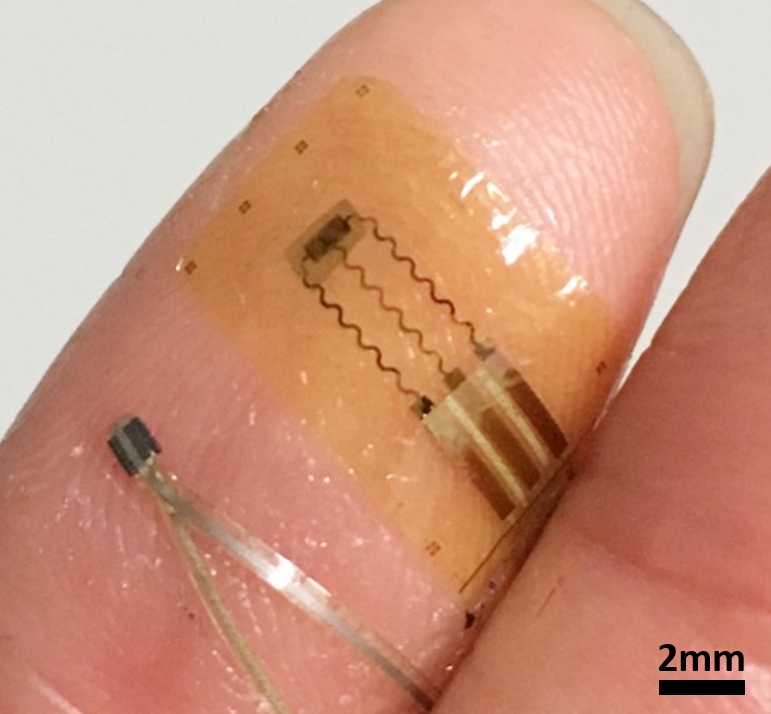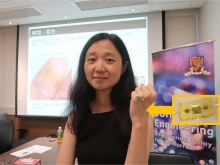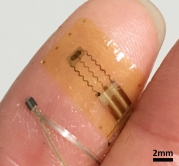CUHK
News Centre
CUHK Faculty of Engineering Develops Ultra-Thin Wearable Blood Pressure Sensor Round-the-Clock, Continuous Measurement to Prevent Acute Health Events
An ultra-thin, unobtrusive blood pressure (BP) sensor that can be worn as a wristband or weaved into clothing has been developed by a research team from the Faculty of Engineering at The Chinese University of Hong Kong (CUHK). Such devices are accurate and low on battery consumption. When connected to a wireless network, they can provide round-the-clock tracking of the user’s BP, so that abnormality can be detected early to advert acute problems such as strokes and heart attacks.
Figures from the Census and Statistics Department indicate that, in 2015, more than half of people aged 65 or above suffer from hypertension, which can lead to higher risks of stroke and other cardiovascular diseases. Automatic and highly accurate BP measurement can help prevent such diseases from occurring and alleviate pressure on carers. The research team led by Prof. Ni ZHAO, Associate Professor and Prof. Yuan-ting ZHANG, Adjunct Professor of the Department of Electronic Engineering at CUHK has studied related technologies since 2014 and their new generation of BP sensor is now undergoing clinical trials at the Prince of Wales Hospital. Professor Zhao points out that, as strokes and heart attacks are most likely to occur at night, a light-weight, non-invasive, and accurate BP sensor can provide real-time and continuous measurement without disrupting the user’s sleep. A long-term record of the user’s BP and heart rate can also enable a more precise assessment of the user’s health.
Traditional BP sensors, which are often worn as a cuff, can only measure intermittently. Continuous monitoring is beyond their reach. The new devices developed by the CUHK team come in many forms. Water-proof and thin as foil, some can be installed in a cuff or earpiece, or sewn into clothing, bedsheets, cushions and pillow cases. Making use of optical, electronic and mechanical measurement techniques, these sensors detect blood flow and monitor various health data through colour reflected by the human skin and the depth of the images. The flexible pressure sensor consumes only 3nW (nano Watt) of power. When the battery is running low, it can switch from optical to mechanical mode of detection, further reducing power consumption to ensure uninterrupted measurement and monitoring.
Professor Zhao believes that in the future, such a sensor should come with artificial intelligence, so that it can learn and improve on itself, with the human body as its teacher, constantly showing it how the body functions and works. The CUHK team will further process data collected by the sensors to see if there are any early warning signs before onset of acute cardiovascular events, so that these conditions can be prevented.
Looking into the future, Professor Zhao believes that when the sensors are widely used, they can help create a database of wide ranging BP and other health records. Such a database would be of great value to medical researches into causes and cures of cardiovascular diseases. The team is also looking into broadening the sensors’ applications into monitoring rate of breathing and blood oxygen level, so that the finger pulse oximeter can be replaced.
Ultra-thin BP Sensor vs Traditional Cuff Sphygmometer
|
|
Ultra-thin BP Sensor |
Traditional Cuff Sphygmometer |
|
Mode of Detection |
In-vitro, non-invasive |
|
|
Safety |
High |
|
|
Accuracy |
High |
|
|
Portability |
High |
Medium |
|
Flexibility of Installation |
High. Can be sewn into clothing or combined with other personal items. |
Low. Measurement must be taken at a certain location. |
|
Ease of Usage |
High |
Medium. The elderly may need assistance to put it on. |
|
Battery Life |
High. When battery is running low, mode of detection can switch from optical to mechanical to further reduce power consumption. |
Low. Stops working once battery runs out. |
|
Continuous Monitoring |
Easily achievable. Can provide 24-hour non-obtrusive monitoring. |
Difficult to achieve. User must cease other activities when measurement is being taken. |
|
Expandability |
High. Can combine with optical technology and artificial intelligence to monitor and record various kinds of health data. |
Low. Measures BP only. |
|
Data Collection |
Massive. It can be connected wirelessly to a network to collect health data for further medical research. |
Minimal. Can only contribute to personal health records. |
CUHK has been recognized as the most innovative university in Hong Kong and ranked 27th in the Asia-Pacific region by the latest ‘Reuters: Asia Pacific’s Most Innovative Universities’.
CUHK has always been committed to promoting innovation and technology. The University currently has more than 750 granted patents in different jurisdictions worldwide. A majority of these patents have been licensed to relevant industries that help bring these innovations to the market to benefit society. In academic year 2016-17, CUHK has received 88 granted patents and filed 183 patent applications for inventions developed in the areas of medical technology, biotechnology, information technology, telecommunications, and materials science. In addition, CUHK has been continuously stimulating entrepreneurship among students and teachers. In 2014, the University introduced the Pre-incubation Centre (Pi Centre). CUHK encourages students and researchers to contribute to society with the knowledge gained through their research. As of now, 32 startups have been launched in areas ranging from novel diagnostic platform to vision guided robotics.





